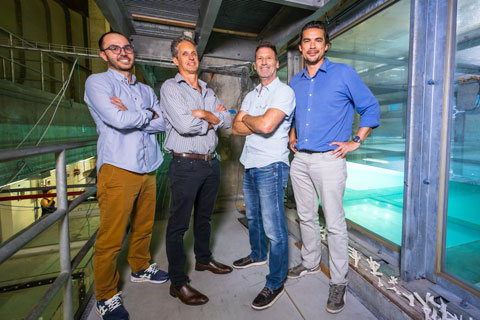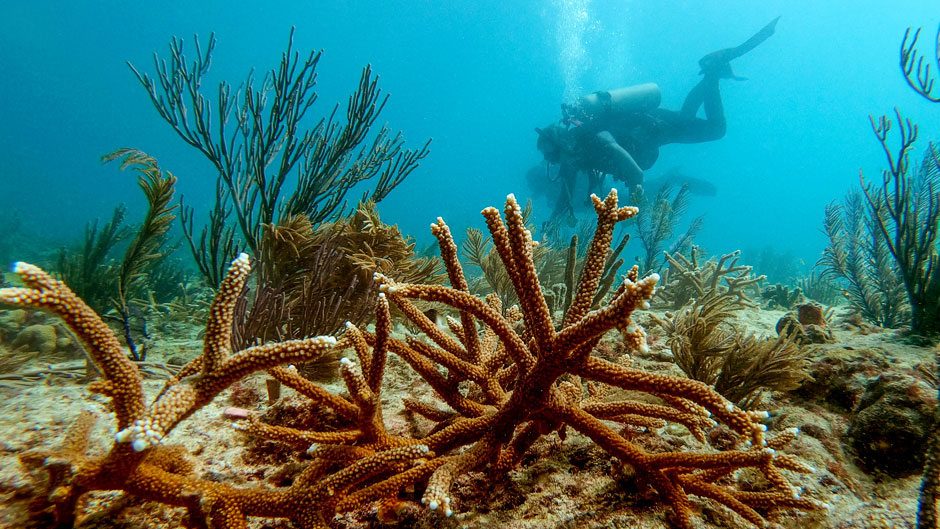They are one of the most critical ecosystems on our planet, providing a nest for marine life and acting as a haven for beauty and biodiversity in our oceans. Not to mention their ability to protect our coastline.
But coral reefs are under attack.
And University of Miami coral experts are deploying a host of innovative techniques to save them. They described these strategies in the second virtual Climate Café, “Building Resilience for Florida’s Coral Reefs and Coastlines,” a webinar hosted by the Rosenstiel School of Marine and Atmospheric Science.
During the webinar, marine science professors Andrew Baker and Diego Lirman outlined the obstacles that coral reefs face today. These include the warming of ocean waters due to climate change, which is fueling coral bleaching events, along with a mysterious illness called stony coral tissue loss disease that is slowly infiltrating the coral species in South Florida. There are also the typical hazards of hurricanes and overfishing that continue to hinder coral reefs.
“In the last 75 years we have seen coral reefs slide in terms of their health status and perhaps the most dire and pressing threat to coral reefs today is that of climate change,” said Baker, professor of marine biology and ecology, who leads the Coral Reef Futures Lab. “I think you can argue that more than any other ecosystem on the planet, coral reefs are most threatened by climate change.”
All these hurdles, Lirman said, led to a recent study that compared Florida’s Coral Reef in 1970—when about 40 percent of the reef floor was comprised of stony corals (such as brain corals and branching corals)—to today, when less than 5 percent of Florida's reef floor contain the same coral.
“For corals that can live hundreds of years, 30 to 40 years is a very short period of time for this dramatic loss,” said Lirman.
Therefore, Baker said, it is critical that scientists utilize as many interventions as possible to restore the coral colonies. Baker and Lirman, along with ocean sciences professor Brian Haus and engineering professor Landolf Rhode-Barbarigos, recently pooled their efforts to create the Southeast Florida Coral Reef Restoration Hub. Through this $6 million project, which is funded by the National Fish and Wildlife Foundation and the University, the professors and their students will partner with coral experts from across the state to restore 125 acres of reef habitat in Miami-Dade and Broward counties using cutting-edge restoration strategies. These include growing and replanting thousands of corals from the University’s two offshore nurseries—along with its land-based hatchery—and juvenile corals from their partners.

Lirman’s Benthic Ecology and Coral Restoration lab, along with his Rescue a Reef program, have taken fragmented corals and grown them and replanted them on reefs in Biscayne Bay for years, refining their methods along the way. In recent years, Rescue a Reef has recruited and trained more than 700 local divers and snorkelers to help grow and plant coral fragments, adding needed assistance to the effort, senior research associate Dalton Hesley said.
"In the past 12 years, we have restored and replanted over 20,000 corals of more than 100 genotypes,” Lirman said. “And we’re not only increasing the abundance or cover of corals, but we’re also increasing the genotypic diversity which is crucial for the sustainability of these coral reefs.”
But as part of the new massive project, Lirman said they will be focusing on planting species and genotypes that thrive in warmer oceans. This is what Baker’s lab is focused on, and Ph.D. student Liv Williamson described how they are working to identify and cultivate corals that are attuned to warmer temperatures.
“It’s not enough to just replace corals, but to replace them with corals that are not likely to succumb to conditions that those before them did,” she said.
Due to the acceleration of climate change, the phenomenon of coral bleaching is the largest threat to the species globally, Baker said. A bleaching event happens when unusually warmer temperatures in the water cause a breakdown between the algae, which grows symbiotically on corals and provides nutrients for them. Without the algae, the corals turn white and brittle. And although not all corals die from bleaching, according to Baker, the longer the events last and the hotter the water gets, the more coral can die.
Another development Williamson noted, is that their lab is working with a type of symbiotic algae that can withstand hotter temperatures. Therefore, in addition to planting and breeding corals that are more resistant and resilient in warmer water, they are also now growing corals with more heat tolerant algae. And they are inoculating some corals with this algae to help them survive.
But Williamson added that one of the best defenses in ecosystems is diversity, so they are also studying the sexual reproduction of corals. When corals spawn once a year, many colonies release eggs and sperm (collectively called “gametes”) at the same time that fertilize one another to form embryos. Each new embryo has its own unique genotype, creating more diversity among the coral species.
Last week, Williamson, Hesley and a team of coral researchers witnessed a spawning event for the first time from staghorn corals they had planted a few years ago through the Rescue a Reef program.
“This is such exciting news because it means not only that we’re able plant new corals and create this beautiful new habitat that had been lost before, but that these colonies are contributing new genetic information and new diversity to our reefs that will help sustain them far into the future—hopefully in the face of climate change,” she said.
And although many Miami residents may not have had the chance to see the coral reefs in person, Lirman said they are instrumental to South Florida’s survival, too. Besides their ability to serve as a refuge for marine life, coral reefs also protect our beaches and homes from massive storm surge by weakening the energy of waves before they get to shore.
“Healthy coral reefs provide the energy mitigation we need to protect our shorelines,” he said. “The annual value of protection in South Florida alone is close to $700 million from coral reefs, and the value of these healthy natural defenses increases significantly when you have extreme events like hurricanes.”
To watch a recording of the webinar, click here. To attend the next Climate Café, “Economic and Societal Impacts of a Changing Climate,” on Wednesday, Sept. 2, from 1 to 2 p.m., register here.

